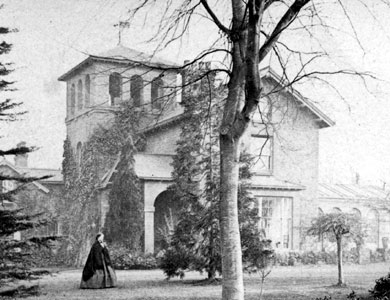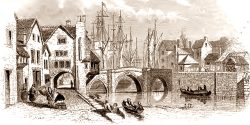
Thomas Clark was born Greinton 16 November 1793, son of Thomas Clark (d.1850) and Mary, nee Metford (d.1837). He was a brother of the John Clark. By 1810 he had moved to Bridgwater, and set himself up as a grocer. We learn this from a letter including in the biography of William Baker, in which Thomas recalled:
“I first became acquainted with our friend in the year 1810. ‘We accidentally met in a stationer’s shop, where I went to purchase some drawing materials he appeared to be there for the same purpose. This led to a conversation, and to his inviting me to his house
Clark became one of the Anstice, Baker and Bowen circle soon after arriving in Bridgwater, and a later friend of his was the Revd J. C. Collins of St John’s Parish Church, with whom he used to go botanising.
He married Elizabeth Bull in 1833 and in the following year he purchased a field in Wembdon, upon which he built Halesleigh Tower, a notable local landmark. Thomas and Elizabeth had one son, Lewis Clark who and died 20 March 1836. Elizabeth died the same day. Their grave marker may be seen in the Quaker burial ground at Bridgwater.

Clark’s was a meticulous botanist, and wrote a paper on the rare plants of the turf moors, published in 1856 by the Proceedings of the Somerset Archaeological and Natural History Society.
His nature diary 1853-1864 is in Blake Museum. As well as notes about the plants he kept a meticulous record of the weather. He died at his residence, Halesleigh, Wembdon; now the Quantock Gateway Hotel.
His neice, Margaret Thompson Sturge recalled him:
‘In his boyhood [Father (Francis James Thompson)] had gone on long walks with Uncle Thomas Clark, and John Collins (Incumbent of St John’s Church), who were great friends, and very good botanists…[ Rev Collins’ daughter, Mrs Escott, recalled] how once, on finding a rare flower, Uncle exclaimed ‘I have found it, I have found it John Collins, Eureka’. When I was about 18, my kind uncle Thomas Clark gave me that pretty little microscope, in a red case, which many will remember. He had made good use out of it in his younger days, but had lately bought a much more powerful instrument. I remember many a pleasant evening at Halesleigh, when he would show us hidden wonders by its aid. Father had a great love and reverence for this uncle, who helped to lead him from the study of Nature, to a fuller knowledge of Nature’s God’.

Thomas wrote “Catalogue of the rarer plants of the turf-moors of Somerset”, which was published in Somerset Archaeological and Natural History Society VII (1858) 64. This seems to have been a reworking of ‘A list of turf-moor plants from the moors of Somersetshire’ which is noted as a donation by Thomas to the exhibition at the temporary museum of the society held in 1855 (PSANHS vol.6, 1855, p.13).
He also contributed notes to various journals. A journal of his, covering 1818-1836, is in the Bowen collection at the Somerset Heritage Centre (DD/CLE/4/14). Thomas’ nature diary covering the period 1820-1864, which is kept in Blake Museum. As well as notes about the plants he kept a meticulous record of the weather:
1820
January 1: Snow on the ground, frosty all day
2: A mild thaw all day with a little rain in the evening
3: Snow in the morning – frosty all day
4: A severe hoar frost last night and during the day – I walked with T. Clark up the river’s side in the afternoon – a great many larks were feeding by the side of the river near the town – Beneath the outer article of bark on an Old Pollard Elm near Mr Mutt’s I found Lebia 4 Macculata which dropped from my hand on trying to secure it and was lost. In a similar situation on another Pollard Elm I found a species of Lebua fromia rusedcence near to me. The only specimen of 4 mallulata which I have was from Mr Miller.
A very dense fog set in about eight o clock this evening
5: All nature is dressed in white this morning – everything is covered with beautiful hoar-frost – from sticks to the wet hand – very serene. Frost all day and the sun scarcely peeps through the fog.
6: The Hoar Frost finer to day than it was yesterday – market folks were nearly with it, particularly about the head and breasts – I never saw the trees hedges and small shrubs and plants so finely ornamented with it. The intensity of the frost slackened towards night.
7: No frost this morning – a fine thaw without rain until about four o clock when it began to freeze severely
8: A sharp black frost all day
9: Very severe frost all day – water and wet things froze in rooms containing fire all the day. Under the bark of a decaying elm near farmer Mutt’s I found several of Endomiches Coccinea and one Fomica 4 mo
10: A little snow fell last night – Frost not so severe today.
1853(?)
April 13: …of food will make great change in this form and col… I have observed them when they have been several days without food in confinement, with their thin dull and dry looking, which became bright and glossy soon after they have a taken a meal of earth-worms or slugs, the works also become larger.
15: Dr Gapper brought me to day [Paelobius Hermani, Hyphydrys feruginius leach, ovatus sandullee, leorcia Geoffrogi, Plea minut issing… Naucoris Ainicoides], all caught by him in the pit in the large field beyond Mr Robert Ford’s. The Plea I have taken in the Brick pits about the town and at Burnham, but the other I have never taken but have received them from collecting friends.
16: I went with Dr Gapper to the sand put and found all the four species abundant there to day.
18: The Taunton fish woman sent me a fish which I cannot find described in any of the books which I possess. It is a beautiful fish partaking the character of Zeus and perca – the jaw is protrusile like the Zeus and its body is deep and much compressed but not so much as that of the zeus – the first dorsal is sponous without filaments. The colour is a mixture of lake and vermilion reponing from the back to the under side (which is silvery) with traverse stripes of the same colour – see drawing.
[in pencil] Note was sent to Mr Yarrite and … in his British Fishes See … also.
Source:
Edward H Milligan, Biographical Dictionary of British Quakers in Commerce and Industry, 1775-1920, 2007, p 110
A P Woolrich 26 January 2011 and 2022. Additions MKP 2020 and 2022.


